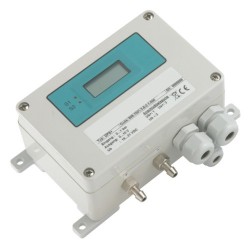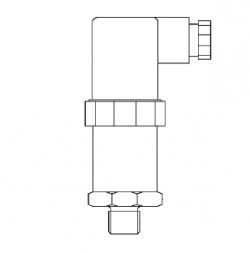
An R&D department developing wood-burning stoves required a robust solution for measuring and logging critical pressure data. The primary challenge was monitoring very low-level chimney draft, a bi-directional pressure of only ±100 pascals, where long-term stability is essential for collecting reliable test data. A secondary requirement was to log ambient atmospheric pressure simultaneously to provide a complete environmental context for the tests. Both sensor types needed to interface seamlessly with an existing multi-channel data logger using a 0-10V signal and a common power supply to prevent ground loop issues.
- Application: Chimney draft and atmospheric pressure monitoring in a wood stove research and development laboratory.
- Challenge: Measuring very low, bi-directional differential air pressures with high stability and compensating for potential sensor drift over long data-logging periods.
- Solution: A combination of a differential pressure transmitter with an automatic zeroing function and a robust absolute pressure transmitter.
- Key Requirement: 0-10V analog outputs for direct integration with an existing multi-channel data acquisition system.
A research and development facility specialising in the design and testing of wood stoves needed to accurately profile the performance of their appliances. A crucial parameter in this research is the measurement of chimney draft, which involves monitoring minute air pressure differences between the flue gas channel and the ambient room pressure. For this R&D application, engineers required a system to continuously log this draft pressure alongside the barometric pressure over extended test cycles. The challenge lay in the nature of the measurement itself; the draft pressures were extremely low, in the range of -100 to +100 pascals, and could be subject to fluctuation. Furthermore, for the integrity of long-term R&D data, it was critical to eliminate the potential for zero-point drift in the low-pressure sensor, which can skew results over time. Manually re-zeroing multiple sensors in the lab was not a viable or repeatable solution.
To address the difficult low-range differential pressure measurement, the DPS series sensor was selected. This instrument utilises a proven inductive measurement system, which is specifically engineered for providing precise and stable readings of extremely low pressures. To meet the customer’s most critical requirement, the device was configured with the optional automatic zero adjustment function. This feature automatically re-calibrates the sensor’s zero point at regular intervals, actively compensating for thermal effects and other sources of long-term drift without any manual intervention. This ensures the validity and repeatability of data logged over many hours or days. The instrument’s configurable bi-directional pressure range of -100 to +100 Pa, a selectable 0-10V output, and compatibility with a 24V power supply allowed for perfect integration with the lab’s existing multi-channel data logger. Additionally, the sensor’s internal damping capabilities help to smooth the output signal when measuring the inherently turbulent pressures found in a chimney draft application.
For the simultaneous measurement of atmospheric conditions, the IMP-LR series low-range pressure sensor was proposed. This sensor was supplied in an absolute pressure range configuration of 750 to 1250 mbar, making it ideal for monitoring barometric pressure changes. A key feature of this transmitter is its microprocessor-based amplifier, which provides highly stable electronics with no mechanical adjustment potentiometers, ensuring reliability and minimising the need for recalibration. Each device is fully temperature-compensated and calibrated before delivery, providing confidence in its accuracy. The robust stainless steel housing and diaphragm offer durability within the lab environment. Just like the differential pressure transmitter, it was configured with a 0-10V, 3-wire output, allowing it to be powered by and connected to the same data acquisition system, simplifying the overall setup and preventing potential grounding and common-mode electrical noise problems.
This combined solution provided the research team with a comprehensive and reliable pressure monitoring system. The highly specialised differential pressure transmitter solved the core challenge of obtaining stable, drift-free measurements of very low chimney draft, while the industrial absolute pressure transmitter delivered the essential barometric data. The shared 0-10V output signal across both devices ensured effortless integration into their data logging hardware, empowering them to gather accurate, time-synchronised data for the development of next-generation heating appliances.

DPS Low Range Draft DP Sensor
- Pressure Range: -100 to +100
- Units: Pa
- Range Type: Bi-Directional Differential (-P to +P)
- Output Signal & Supply Type: 0-10V 3-wire, 19-35Vdc supply
- Output Options: Linear signal
- Accuracy (linearity only): 1% full scale
- Electrical Connection: M12 x 1.5 cable glands with 5 internal screw terminals
- Process Connection: 6.6mm dia x 11mm barbed connections
- Media Compatibility: Non aggressive gases compatible with Ni, Al, CuBe, PU, silicon rubber
- Optional Extras: Integrated LCD display, 3 1/2 digit, Auto-Zero Function

IMP-LR Barometric Pressure Sensor
- Pressure Range: 750 to 1250
- Units: mbar
- Range Type: Absolute (0 to +P)
- Output Signal: 0 – 10V, 3-wire (7)
- Non-Linearity and Hysteresis: 0.25% FS (standard) (A)
- Thermal Zero Shift: 0.04% FS per °C (standard) (4)
- Electrical Connection: Large Plug & Socket (B)
- Process Connection: G1/4 male DIN 3852 (A)
- Media Exposed Seals: Viton (V)
